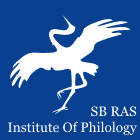 |
|
||||||||||||
|
Institute of Philology of
the Siberian Branch of Russian Academy of Sciences |
|
||||||||||||
|
|||||||||||||
| Sibirskii Filologicheskii Zhurnal (Siberian Journal of Philology) | |
|
Article
Authors: N. B. Koshkareva Institute of Philology of the Siberian Branch of the Russian Academy of Sciences, Novosibirsk, Russian Federation; Novosibirsk State University, Novosibirsk, Russian Federation In the section Linguistics
Abstract: The semantic core of actional sentences is the relationship of purposeful influence on the ob- ject by the active, controlling subject. The impact is carried out in the physical sphere and repre- sents the causation of the existence or non-existence of the object, as well as the causation of the transition from one state to another. Hence, there are two semantic types of actional sentences ‒ creative and destructive action, on the one hand, and the transformation of the object, on the oth- er. The complex of causal-aspectual relations is superimposed on the elementary meanings of existence and state. The following lines of metaphorical transfers are identified, with the physical sphere being the starting point: 1) figurative values, resulting in a system of polysemants ‒ elementary simple sentences with semantics derived from the original one ‒ based on actional typical syntactic structure: 2) the transfer of meaning from the physical sphere to the mental and intellectual ones, with syntactic homonyms being formed ‒ non-elementary simple and polypredicative constructions with modus-dictum relations (constructions with sentential predicates). The position of the object is replaced either by the names of abstract semantics, or by words representing the reduced propo- sitions, or by predicative actants. The criterion for classifying these sentences as homonyms is their non-elementary semantics. Keywords: Khanty language, Nenets language, elementary simple sentence, syntax of the model structure, actional sentences, the subject-object relationship, syntactic metaphor, synony- my, polysemy, homonymy Bibliography: Barkalova M. V. Funktsional’no-semanticheskaya klassifikatsiya glagol’nykh modeley nenetskogo yazyka [Functional-semantic classification of verbal models of the Nenets language]. Yazyki korennyh narodov Sibiri. Novosibirsk, 2004, iss. 14, pp. 171–217. Csepregi M. Szurguti osztják chrestomathia [Reference book of the Surgut dialect of the Khanty language]. Studia Uralo-Altaica. Suppl. 6, Szeged, 1998. Nenetskiy fol’klor [Nenets folklore]. Moscow, 1960. Shmeleva T. V. Semanticheskiy sintaksis [Semantic syntax]. Krasnoyarsk, 1988. Solovar V. N. Modeli prostykh predlozheniy khantyyskogo yazyka s dvukhmestnymi predikatami [Models of simple sentences of the Khanty language with transitive predicates]. In: Predlozhenie v yazykah severa Sibiri [A sentence in the languages of the north of Siberia]. Novosibirsk, 1989, pp. 47‒55. Solovar V. N. Modeli elementarnykh prostykh predlozheniy s pryamym ob”yektom v khantyyskom yazyke [Models of elementary simple sentences with direct object in Khanty language]. Yazyki korennyh narodov Sibiri. Novosibirsk, 2002, iss. 8, pp. 58‒67. Solovar V. N. Paradigma prostogo predlozheniya v khantyyskom yazyke [The paradigm of a simple sentence in the Khanty language]. Novosibirsk, Lyubava, 2009, 250 p. Sosa S. Functions of morphosyntactic alternations, and information flow in Surgut Khanty discourse: Doctoral dissertation. Helsinki, 2017, 254 p. Vsevolodova M. V. Teoriya funktsional’no-kommunikativnogo sintaksisa: Fragment prikladnoy (pedagogicheskoy) modeli yazyka: Uchebnik [Theory of functional-communication syntax: Fragment of applied (pedagogical) model of language: Textbook]. Moscow, MSU Publ., 2000. |
 |
Institute of Philology Nikolaeva st., 8, Novosibirsk, 630090, Russian Federation +7-383-330-15-18, ifl@philology.nsc.ru |
© Institute of Philology |


